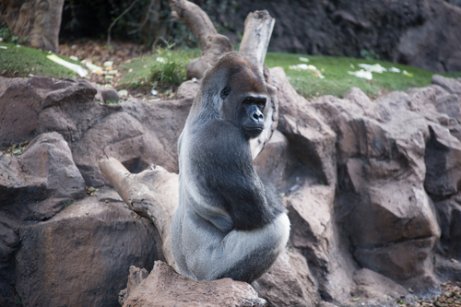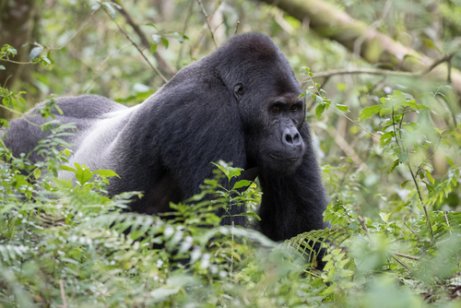Western Gorilla: The Largest Primate In The World
Did you know that humans share 98% of their DNA with gorillas? Or that the western gorilla is currently the largest primate in the world? Also, you might not believe it, but these animals are herbivores! Let’s take a closer look at one of the most fascinating species in Africa.
Gorillas and Mankind
One of the differences between us and gorillas is that gorillas walk on four legs and their front limbs are longer than ours. Although they can reach the same height as an adult human between 5′ 7″ and 6′ 6″, but they are much heavier than humans. They can weight up to 200 kilos.
Another trait that separates humans from gorillas is facial structure. Gorillas have a protruding jaw. They are also herbivores and eat fruits and leaves. Their life expectancy is about 40 years. The young only live with their mother until they are about four years old.
Gorillas are divided into two species: western and eastern. Within these groups, there are subspecies. The western gorilla is divided into lowland gorillas and cross river gorillas. Eastern gorillas are divided into mountain and lowlands.
Traits of the Western Gorilla
Within the gorilla family, the western gorilla is the most common. Experts estimate there is a population of 100,000 specimens. They spend most of the day eating and resting. Every day they prepare their “beds” with leaves in tree branches or on the ground. However, males more commonly sleep on the ground.

A gorilla family has several members: a dominant male (that can be spotted due to his size and silver coloring on his back), up to two subordinate males, and several females with children. Their territory ranges from 200 to 5,000 hectares, but they have no problems sharing spaces with other groups.
Males reach sexual maturity at 12 and females at eight years old. Females have a menstruation cycle every 28 days and only have one child per pregnancy, around every five years. Their pregnancy can last up to eight months, and once bor, the babies can weigh around two kilos.
You can notice the difference between Western Lowland Gorillas and Cross River gorillas based on your location. Lowlands inhabit the forests and plains of Angola, Cameroon, Congo, Gabon, and Equatorial Guinea.
The latter live in the tropical jungles between Nigeria and Cameroon. They differ from Lowland Gorillas by the shape of their skulls and size of their teeth. Out of all the gorillas, this is the most threatened. There are only about 300 living in the wild. They are very shy and flee at the slightest sign of danger or human presence.
Traits of the Eastern Gorilla
The Bberingei Gorilla is the largest gorilla species and is also divided into two subspecies. On the one hand, there is the Mountain Gorilla which only around 700 of this subspecies is left. Then, on the other, there is the Eastern Lowland Gorilla which is more common. There are around 16,000 living in the wild.

The mountain subspecies can be found in Central Africa in Volcanoes National Park, Mgahinga and Virunga National Parks, and in Rwanda, Congo, and Uganda. War, hunting, loss of natural habitat, and the spread of human diseases are the main threats to this species. They are currently in a critical condition of becoming extinct.
The Mountain Gorilla has longer and darker hair than its relatives. This is because they have adapted to living in areas where the temperature can drop to 0 degrees Celcius. Every individual gorilla has a different nose than the others, and males are taller and heavier than females.
On the other hand, the Lowland Gorilla has a broader torso. They also have a more pronounced jaw and longer teeth. The males also have silver coloring on their backs once they reach sexual maturity.
These gorillas are herbivores and in a single day, they are capable of eating all the leaves of an entire tree. They also eat seeds, fruits, bamboo, and, sometimes insects. The Eastern Lowland Gorilla is peaceful, sociable, and lives in groups of up to 30members. There is always a dominant male and several females.
Pregnancy in female gorillas lasts eight and a half months and they can only have one baby per pregnancy. The baby crawls at nine months, feeds on breast milk for the first year of life, and walks around a year and half old, which is very similar to human babies!